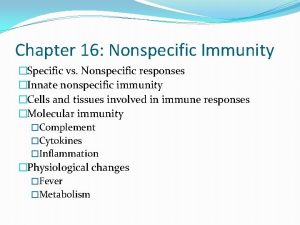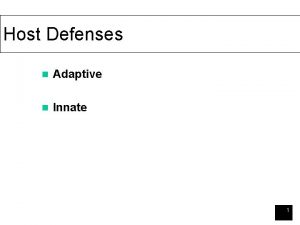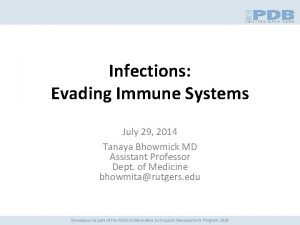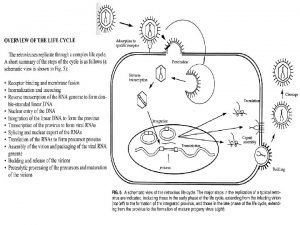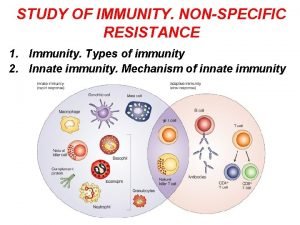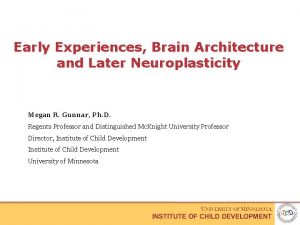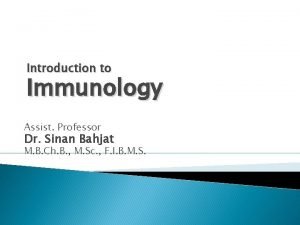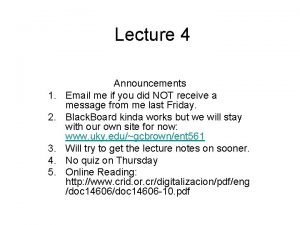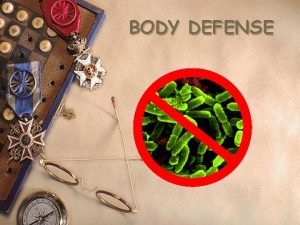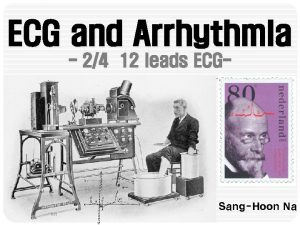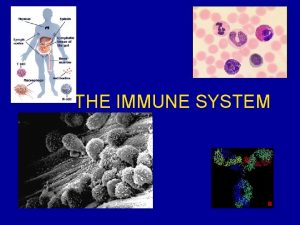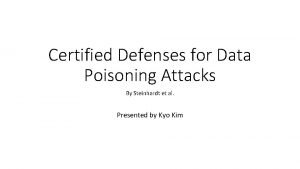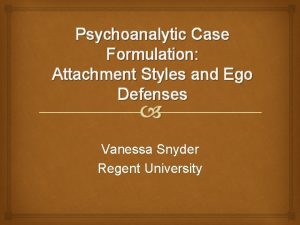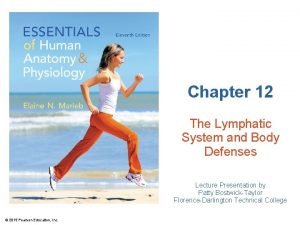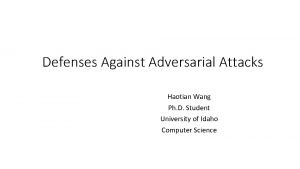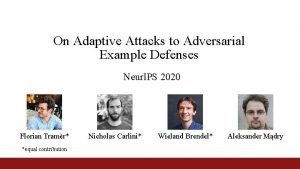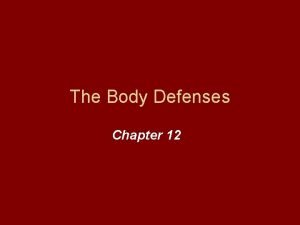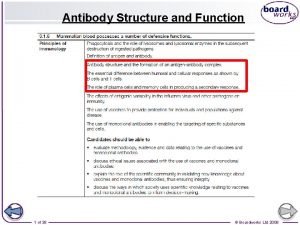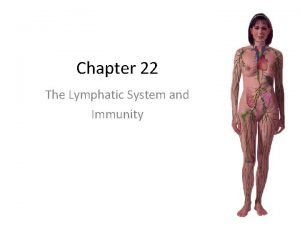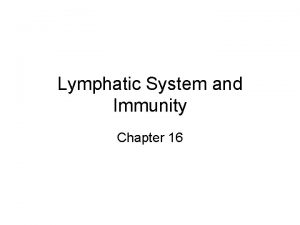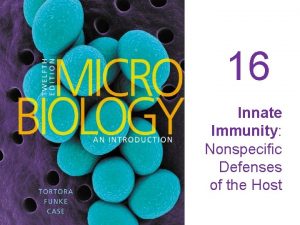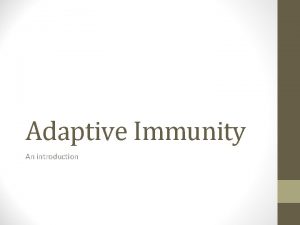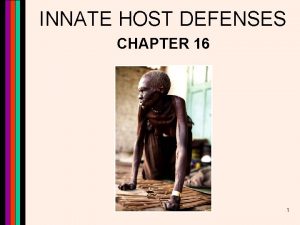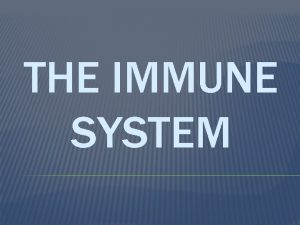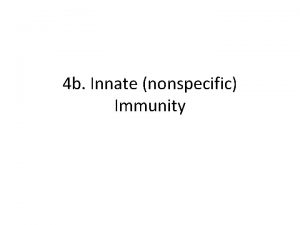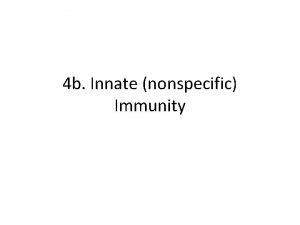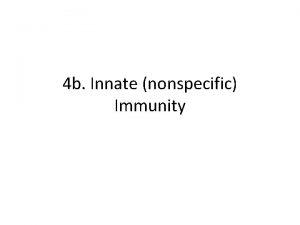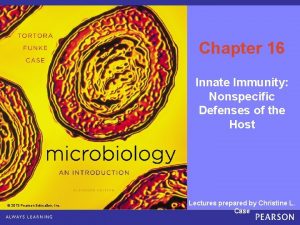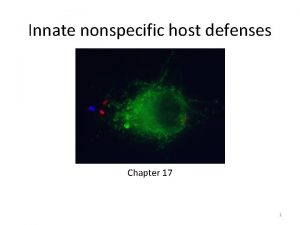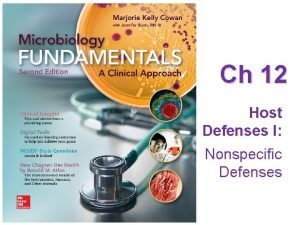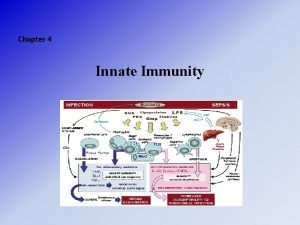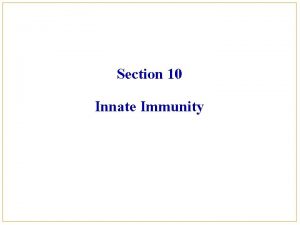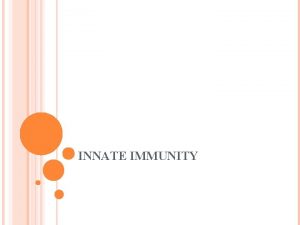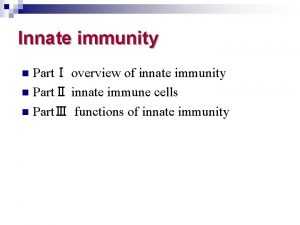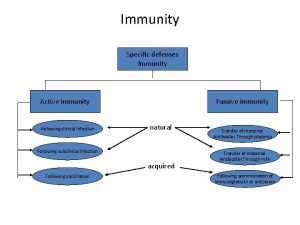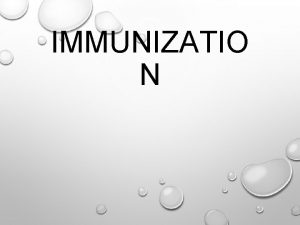16 Innate Immunity Nonspecific Defenses of the Host






























- Slides: 30

16 Innate Immunity: Nonspecific Defenses of the Host

SLOs Differentiate between innate and adaptive immunity. Define toll-like receptors. Differentiate physical from chemical factors, and list examples of each. Describe the role of normal microbiota in innate resistance. Classify phagocytic cells, and describe the roles of granulocytes and monocytes. Define and explain phagocyte and phagocytosis. Explain the different stages of inflammation. Describe the cause and effects of fever. Describe two of the three pathways of activating complement and describe the 3 outcomes. Compare and contrast the actions of -IFN and -IFN with -IFN. Describe the role of transferrins and antimicrobial peptides in innate Copyright © 2006 Pearson Education, Inc. , publishing as Benjamin Cummings

TLRs on M s, dendritic cells, epithelial cells Cytokines! PAMPs recognition

Horseshoe structure of TLR 3, showing attached sugars (spheres) and internal structures Fig. 16. 7

The Concept of Immunity § Susceptibility: Lack of resistance to a disease. § Immunity: Ability to ward off disease. § Innate immunity: Defenses against any pathogen. § Adaptive immunity: Immunity, resistance to a specific pathogen. Fig 16. 1 Copyright © 2006 Pearson Education, Inc. , publishing as Benjamin Cummings

First Line of Defense: Skin and Mucous Membranes Physical Factors § Epidermis: consists of tightly packed cells with keratin, a protective protein § Two other protective physical factors of skin? § Mucus of mucous membranes § Lacrimal apparatus § Saliva § Nose hairs § (Muco)-ciliary escalator Copyright © 2006 Pearson Education, Inc. , publishing as Benjamin Cummings Fig 16. 3

Chemical Factors § Fungistatic fatty acids in sebum § Low p. H (3 -5) of skin § Lysozyme in ____________ § Low p. H (? ) of gastric juice § Transferrins in blood Also important: Antagonism and competitive exclusion of normal microbiota Copyright © 2006 Pearson Education, Inc. , publishing as Benjamin Cummings

1 st Line Defense in Human ANIMATION Host Defenses: The Big Picture

Second Line of Defense: Formed Elements in Blood Compare to Table 16. 1 60 -70% 2 -4% 0. 5 -1%% 3 -8% 20 -25% Copyright © 2006 Pearson Education, Inc. , publishing as Benjamin Cummings

Process of Phagocytosis Phagocytes engulf and kill microorganisms Steps of phagocytosis: • Chemotaxis • Recognition and attachment • Engulfment and creation of phagosome • Fusion of phagosome with lysosome • Destruction and digestion • Residual body Exocytosis Copyright © 2006 Pearson Education, Inc. , publishing as Benjamin Cummings Fig 16. 7

Phagocytosis Foundation Fig 16. 7

Microbial Evasion of Phagocytosis Inhibit adherence: M protein, capsules Kill phagocytes: Leukocidins Streptococcus pyogenes, S. pneumoniae Staphylococcus aureus Lyse phagocytes: Membrane attack complex Listeriamonocytogenes Escape phagosome Shigella Prevent phagosomelysosome fusion HIV Survive in phagolysosome Coxiella burnetti

Phagocytosis and Evasion of Phagocytosis ANIMATION Phagocytosis: Overview ANIMATION Phagocytosis: Mechanism Review the Following Textbook Animations ANIMATION Virulence Factors: Hiding From Host Defenses ANIMATION Virulence Factors: Inactivating Host Defenses ANIMATION Phagocytosis: Microbes That Evade It Copyright © 2006 Pearson Education, Inc. , publishing as Benjamin Cummings

Inflammation Tissue damage leads to inflammatory response Purpose: § Destroy pathogen § limit spread of infection § pave way for tissue repair 4 cardinal signs: ? Acute-phase proteins (Chemical mediators) activated: § Complement proteins § Cytokines § Specialized proteins such as fibrinogen and bradykinin Copyright © 2006 Pearson Education, Inc. , publishing as Benjamin Cummings

The Three Stages of Inflammation 1. Vasodilation and increased vessel permeability due to histamine (and other cytokine) release edema 2. Phagocyte migration and phagocytosis q Margination and diapedesis (emigration) q Chemotaxis(due to various cytokines and components of complement system) q Pus formation q Factors challenging effectiveness of phagocytosis 3. Tissue repair and regeneration depends on type of tissue Copyright © 2006 Pearson Education, Inc. , publishing as Benjamin Cummings

Inflammatory Process Margination Diapedesis Compare to Fig 16. 8

Treatment of abscess?

Fever: Abnormally High Body Temperature § Hypothalamus acts as body’s thermostat § Endotoxin causes phagocytes to release interleukin– 1 (IL– 1). IL-1 is an endogenous pyrogen § Hypothalamus releases prostaglandins that reset thermostat § Body reacts to raise the temperature. How? § When no more IL– 1, body temperature falls (crisis). Copyright © 2006 Pearson Education, Inc. , publishing as Benjamin Cummings

Beneficial effects of moderate fever: Inhibited pathogen growth Increased cellular metabolism e. g. : § Increased transferrin production § Increased IL– 1 activity T cell production § Faster repair mechanisms Problematic effects of high fever: > 40. 7 C (105 F) can be dangerous (Tachycardia, acidosis, dehydration) Death at temp. > 44 - 46 C

Antimicrobial Substances 1. The complement system 2. Interferons 3. Transferrins: bind serum iron 4. Antimicrobial peptides: cause bacterial cell lysis. Produced by mucous membrane cells and phagocytes. Copyright © 2006 Pearson Education, Inc. , publishing as Benjamin Cummings

The Complement System Compare to Foundation Fig 16. 9

Complement System Summary Series of 30 plasma (serum) proteins, activated in a cascade Three effects of complement system: 1. Enhances inflammatory response, e. g. : attracts phagocytes 2. Increases phagocytosis through opsonization or immune adherence 3. Creates Membrane Attack Complexes (MACs) Cytolysis Copyright © 2006 Pearson Education, Inc. , publishing as Benjamin Cummings

Opsonins (complement proteins or antibodies) coat bacteria and promote attachment of micro -organism to phagocyte Opsonization

Classical Pathway Fig 16. 12

Alternative Pathway Does not require a specific antibody to get started Fig 16. 13 Copyright © 2006 Pearson Education, Inc. , publishing as Benjamin Cummings

Some Bacteria Evade Complement § Capsules prevent Complement activation. § Surface lipid-carbohydrates of some Gramnegatives prevent MAC formation. § Enzymatic digestion of C 5 a by Grampositives. ANIMATION Complement System: Overview ANIMATION Complement System: Activation ANIMATION Complement System: Results Copyright © 2006 Pearson Education, Inc. , publishing as Benjamin Cummings

Interferons (IFNs) § Family of glycoproteins § Host-cell-specific but not virus-specific § -IFN and -IFN: Produced by virus infected cells. Mode of action is to induce uninfected cells to produce antiviral proteins (AVPs) that inhibit viral replication. § -IFN: Produced by lymphocytes. Causes neutrophils and macrophages to phagocytize bacteria. Also involved in tumor immunology. § Recombinant interferons have been produced. However short-acting and many side-effects. No effect on already infected cells. Copyright © 2006 Pearson Education, Inc. , publishing as Benjamin Cummings

Interferons (IFNs) Fig 16. 15 Copyright © 2006 Pearson Education, Inc. , publishing as Benjamin Cummings

Unnumbered Figure 16. 1 a Applications of Microbiology: Serum Collection

Unnumbered Figure 16. 1 b
 Difference between acquired immunity and innate immunity
Difference between acquired immunity and innate immunity Nonspecific vs specific immunity
Nonspecific vs specific immunity Nonspecific host defense mechanism
Nonspecific host defense mechanism Host defenses
Host defenses Innate immunity first line of defense
Innate immunity first line of defense Assis. prof.
Assis. prof. Innate immunity
Innate immunity Salmonella life cycle
Salmonella life cycle Innate immunity examples
Innate immunity examples Innate immunity first line of defense
Innate immunity first line of defense Innate immunity
Innate immunity Non specific innate immunity
Non specific innate immunity Innate immunity first line of defense
Innate immunity first line of defense Innate immunity first line of defense
Innate immunity first line of defense Definitive host vs intermediate host
Definitive host vs intermediate host Specific vs nonspecific defense
Specific vs nonspecific defense Westermark sign
Westermark sign J point
J point Specific defense vs nonspecific defense
Specific defense vs nonspecific defense схема імунної відповіді
схема імунної відповіді Certified defenses for data poisoning attacks
Certified defenses for data poisoning attacks What are the ego defense mechanisms
What are the ego defense mechanisms Chapter 12 the lymphatic system and body defenses
Chapter 12 the lymphatic system and body defenses Chapter 12 the lymphatic system and body defenses
Chapter 12 the lymphatic system and body defenses Certified defenses against adversarial examples
Certified defenses against adversarial examples Neur ips
Neur ips Chapter 12 the lymphatic system and body defenses
Chapter 12 the lymphatic system and body defenses Immunity
Immunity The difference between humoral and cell mediated immunity
The difference between humoral and cell mediated immunity Lymphatic system composed of
Lymphatic system composed of Chapter 16 lymphatic system and immunity
Chapter 16 lymphatic system and immunity

